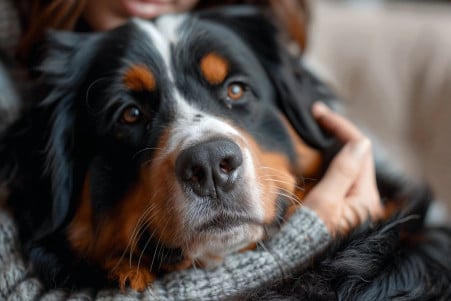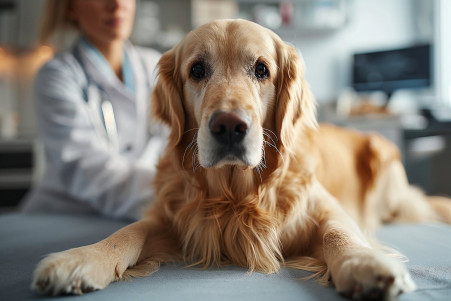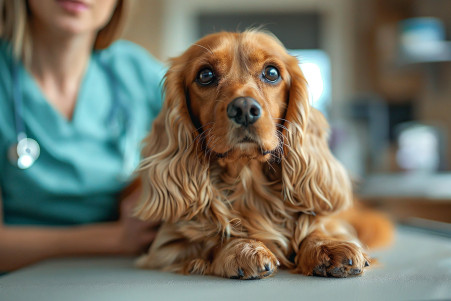Signs of Trouble After Dog Spaying: What Dog Owners Need to Know
7 May 2024 • Updated 6 May 2024

If you’ve recently had your dog spayed, you’re probably keeping an eye out for any signs of trouble as your pet recovers from the surgery. While spaying is a common procedure, some of the most frequent signs of trouble after spaying include licking or chewing at the incision, vomiting, diarrhea, pale gums, and signs of pain or discomfort such as crying or an inability to get comfortable. If you see any of these signs, make sure to call your vet right away.
To make sure you know what to look for, we’ll look at advice from veterinarians and studies that have investigated the typical dog spaying recovery time. This information will help you understand what’s normal during the recovery process, what you should be cautious of, and when you should consider getting additional help. This information will help you make sure you’re taking the best care of your dog after surgery so that they can recover as quickly and comfortably as possible.
What are the warning signs to look for after a dog has been spayed?
Signs and Symptoms to Look Out For
According to TryFi's article, some lethargy and loss of appetite can be expected in the first 24-48 hours after the procedure due to the after-effects of anesthesia and the surgery. That said, if your dog is still acting lethargic after a few days, there may be an underlying issue that needs to be addressed by a vet.
Loss of appetite that lasts for more than 24 hours can also be a sign of pain, nausea or other issues that have arisen from the surgery, according to Apple Valley Animal Hospital. It's also normal for the incision to be slightly red, swollen and have a small amount of discharge at first, but if the area is very swollen, has pus or smells bad, it may be infected and require antibiotics.
One of the most important things to look out for is if your dog is licking, chewing or scratching at the incision. This can lead to an infection, slow the healing process and even cause the incision to open up, according to a study from NIH. It's recommended that you use an Elizabethan collar to prevent this.
Finally, vomiting, diarrhea, pale gums and difficulty urinating or defecating can all be signs of internal bleeding, dehydration or other serious issues that require immediate medical attention. As VCA Animal Hospitals explains, make sure to reach out to your vet if you have any concerns during this time.
Potential Risks and When to Go to the Vet
According to MetLife Pet Insurance, infection at the incision site is the most common risk of spaying and can be identified by swelling, redness, discharge, or a bad smell. Another risk is internal bleeding, which can be identified by blood seepage that lasts longer than a few days, bruising, or pale gums, according to PawSafe.
Allergic reactions to anesthesia or medications can cause vomiting, diarrhea, and difficulty breathing, according to Danbury Vet. Other risks include the incision reopening or not healing properly, and these should be checked out by a vet. If you notice any symptoms that concern you or that don’t go away, or if your dog is in a lot of pain, you should take them to the vet right away.
Spay Surgery Aftercare and Recovery Instructions
Following the spay surgery, it is important to make sure your dog has a safe, comfortable place to rest and recover. Per Sonoma County Animal Services, you should keep your pet in a clean, indoor environment away from other pets and kids for at least the first 12 hours. You can offer small amounts of water and their regular food, but don’t give anything by mouth if vomiting occurs.
To ensure the incision heals properly, PetMD suggests limiting your dog’s activity and exercise for 10-14 days or as recommended by your vet. This means keeping your dog on a leash when you take them outside and preventing them from jumping, running, or playing too hard. You should also use an Elizabethan collar or an alternative, like a onesie or boxer shorts, to keep your dog from licking or chewing at the incision site.
The Animal Humane Society says to make sure the incision area stays clean and dry and to check it daily for signs of potential problems, including excessive swelling, redness, or discharge. It’s also important to make sure you’re following your vet’s instructions for medications, wound care, and any necessary follow-up visits to ensure your dog has a safe and successful recovery.
Getting Back to Regular Activity and Routines
Most dogs will be able to get back to their regular activity and routines within 10-14 days after the surgery, says PetMD. However, the recovery time can depend on the dog’s age, size, and other factors. Larger dogs and older dogs will take longer to recover, and it can take up to a month before they can go back to their regular exercise and play schedule, says Embrace Pet Insurance.
You should make sure to reintroduce exercise and activity slowly, starting with short, leashed walks and then gradually increasing the time and intensity, explains Vet Help Direct. Make sure to avoid any strenuous exercise, running, jumping, or rough play until the incision has fully healed and your vet has given you the go-ahead. Keep a close eye on your dog as you start to transition them back to their regular routine and look for any signs of discomfort or issues.
Spaying and Potential Health Risks
Spaying is often recommended by veterinarians to avoid unwanted litters and certain health problems in female dogs. The American Kennel Club notes that unspayed dogs are at risk of developing pyometra, a life-threatening uterine infection that is caused by hormonal changes and bacterial overgrowth. Spaying can also lower the risk of certain cancers, including mammary and ovarian cancer, especially if the procedure is done before the dog's first heat cycle.
That said, more recently, studies have shown that spaying can increase the risk of certain orthopedic disorders and other health problems in some breeds, and that the age at which the procedure is done can play a role. One study published in Frontiers in Veterinary Science found that the risk of joint disorders was influenced by the dog's size, and that larger dogs were more likely to develop these issues if they were neutered. The study also found that the dog's sex was a factor in some of the health problems that were associated with neutering.
It's important to talk to a vet about the potential risks and benefits of spaying in order to decide whether or not to go through with the procedure and when to do it based on the dog's age, breed, and other individual health factors. As UC Davis points out, the decision to spay or neuter and the timing of the procedure should be individualized to each dog in order to weigh the potential benefits and risks.
Conclusion: How to Help Your Dog Recover Successfully
Once your dog has had the spaying procedure, it's important to make sure that they have a safe, comfortable place to rest and recover. Sonoma County Animal Services recommends keeping your pet in a clean indoor environment that's separate from other pets and kids for at least the first 12 hours. You can give them small amounts of water and their regular food, but don't give them anything by mouth if they start to vomit.
To make sure that the incision heals properly, PetMD suggests that you limit your dog's activity and exercise for 10-14 days, or as directed by your vet. This means that you should walk your dog on a leash and keep them from jumping, running, or playing too hard. You should also make sure that your dog can't lick or chew at the incision by using an Elizabethan collar or a suitable alternative, like a onesie or boxer shorts.
The Animal Humane Society also says that you should make sure the incision stays clean and dry and check it every day for signs of potential problems, like excessive swelling, redness, or discharge. Make sure that you also follow your vet's instructions for giving your dog any prescribed medication, caring for the wound, and scheduling any necessary follow-up appointments to make sure that your dog has a smooth, successful recovery.
By following your veterinarian's guidance and being vigilant during the recovery period, you can help ensure your furry companion's well-being and a safe, successful recovery after spaying.


